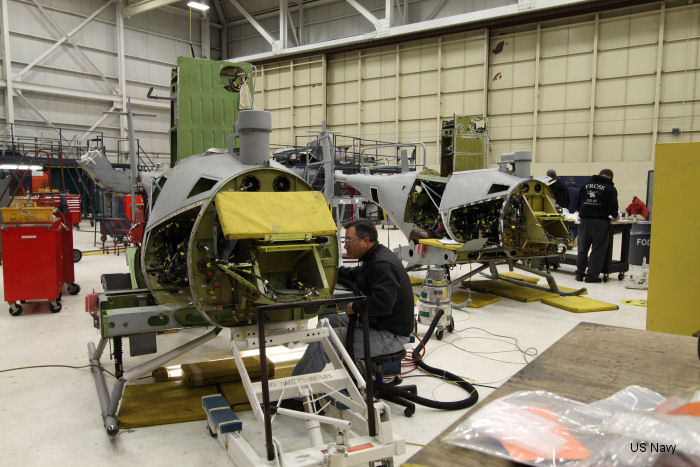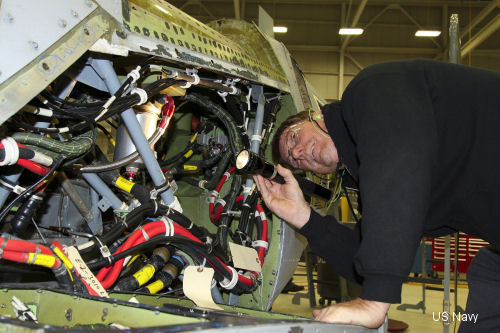US Naval Air Systems Command (NAVAIR), April 04, 2014 - JACKSONVILLE, Fla. - Artisans at Fleet Readiness Center Southeast (FRCSE) Detachment (DET) Mayport are diligently overhauling several MQ-8B Fire Scout Vertical Take-Off and Landing Tactical Unmanned Aerial Vehicles (VTUAV) to meet the deployment needs of the fleet.
The U.S. Navy currently has an inventory of 23 Fire Scouts based at Webster Field Annex, Naval Air Station Patuxent River, Md. The aircraft assigned to Naval Air Systems Command (NAVAIR) and Commander, Naval Air Forces, deploy on board guided missile frigates (FFG) providing intelligence, surveillance and reconnaissance (ISR). The MQ-8B will also deploy on littoral combat ships (LCS) as part of the anti-submarine warfare/anti-surface warfare/mine countermeasures mission package.
“Navy requirements call for four Fire Scouts being deployed on frigates and one on the LCS,” said Jon Stafford, FRCSE business operations manager. “The fleet will deploy one Fire Scout at a time on board the LCSs during their 16-month deployments and swaps them out at the eight-month mark for a material condition and aircraft corrosion inspection.”
Stafford explained that the program office and Fleet Support Team are working to repackage the current depot specification to better integrate with the LCS 16-month deployment concept of operation. This will likely include depot field teams to perform assessments in-theater and evaluate the aircraft for continued operation at sea.
“Currently, the ship pulls in, the aircraft are sent to the depot for a full aircraft condition inspection (ACI),” said Stafford. “Having the Fleet Readiness Centers close to the operator and ships, expedites the ACI process.”
To date, artisans at FRCSE DET Mayport have overhauled four Fire Scouts and have completed stand-alone modifications on 10 other aircraft since June 2013.
“The program was first introduced here in early 2013 when Fleet Readiness Center East (FRCE) needed help in supporting field modification work in the Indian Ocean aboard deployed ships,” said FRCSE Vertical Lift Integrated Product Team Deputy Manager Bill McGorty.
“After working with Program Manager Air 266 on that support, we were asked to perform ACIs on the Fire Scouts,” continued McGorty. “We expect to work on up to eight aircraft each year at Naval Station (NS) Mayport for ACI and associated modifications.”
Upon arrival at the NS Mayport hangar, artisans disassemble the aircraft to determine the depth of rework needed. The aircraft is broken up into four different zones including the engine, propulsion, drive train and avionics. All major components are removed by field experts, inspected, tagged and documented for storage. After further inspection by aircraft examiners and evaluators, they are either reissued back to the aircraft or deemed unusable and new parts are ordered.
“If the parts aren’t available, they must be specifically made for the Fire Scout,” explained FRCSE DET Mayport Site Manager Noel Green. “Our inspectors [sheet metal, avionics, electrical and mechanic] check each individual part on the aircraft for corrosion, broken parts and bad wiring. The Fire Scouts have many hours of flying time at sea, so we are finding many corrosion issues. Artisans reassemble the aircraft once everything passes inspection. Then we test the wiring and ship it back to Webster Field for ground and flight testing.”
According to McGorty, the process is set to take 120 days. “The fleet, with so few assets, has put a great deal of demand on FRCSE, as well as FRCE, to provide assets for deployment,” he said. “Our folks at Mayport have risen to the challenge and worked within the required turnaround time to get the fleet what it needs. Recent short turnaround times required seven-day-a-week work schedules through the Christmas break and our team came through with flying colors to meet the challenge.”
Another challenge for the artisans was to learn the intricate components of the new aircraft. PMA-266 contracted with Northrup Grumman Corporation which built the Fire Scouts to provide technical advice and training to the FRCSE team.
“We normally work on the H-60 helo line and have had to learn a whole new system,” said Green. “When we were tasked with this requirement, we put together a special team to work specifically on the Fire Scout. Tech reps from Northrup Grumman came in to give us familiarization classes and on-the-job training. It worked well getting hands-on training while overhauling our first Fire Scout.”
“Our counterparts at FRCE have worked on these aircraft longer than we have, so we also collaborate with them when issues arise and we need assistance,” he added.
In May, the team expects to earn their “declaration of capability,” which according to McGorty means that FRCSE has the capability to perform ACI and modification work on the MQ-8B Fire Scout and have a process in place to meet fleet requirements when called upon.
The Fire Scout is designed to provide ISR capability to the LCS mission package. With the shift in the LCS schedule to the right, it was utilized to meet urgent operational needs for critical ISR support on board FFG class ships. It was first deployed in September 2009 on board USS McInerney (FFG 8) where it detected a speedboat and a support vessel engaged in smuggling cocaine in the Eastern Pacific, allowing the ship to confiscate 60 kilograms of cocaine and detain multiple suspects.
The aircraft have since been deployed to Afghanistan and Africa for intelligence, surveillance, and reconnaissance purposes. During the 2011 military intervention in Libya, Helicopter Anti-Submarine Squadron Light 42 (now Helicopter Maritime Strike Squadron 72 based at NAS Jacksonville operated two Fire Scouts on board USS Halyburton (FFG-40) as part of Operation Unified Protector.
Between 2006 and 2013, the Fire Scout flew more than 8,000 hours, with more than half in real-world operations on ships and land.
The U.S. Navy currently has an inventory of 23 Fire Scouts based at Webster Field Annex, Naval Air Station Patuxent River, Md. The aircraft assigned to Naval Air Systems Command (NAVAIR) and Commander, Naval Air Forces, deploy on board guided missile frigates (FFG) providing intelligence, surveillance and reconnaissance (ISR). The MQ-8B will also deploy on littoral combat ships (LCS) as part of the anti-submarine warfare/anti-surface warfare/mine countermeasures mission package.
“Navy requirements call for four Fire Scouts being deployed on frigates and one on the LCS,” said Jon Stafford, FRCSE business operations manager. “The fleet will deploy one Fire Scout at a time on board the LCSs during their 16-month deployments and swaps them out at the eight-month mark for a material condition and aircraft corrosion inspection.”
Stafford explained that the program office and Fleet Support Team are working to repackage the current depot specification to better integrate with the LCS 16-month deployment concept of operation. This will likely include depot field teams to perform assessments in-theater and evaluate the aircraft for continued operation at sea.
“Currently, the ship pulls in, the aircraft are sent to the depot for a full aircraft condition inspection (ACI),” said Stafford. “Having the Fleet Readiness Centers close to the operator and ships, expedites the ACI process.”
To date, artisans at FRCSE DET Mayport have overhauled four Fire Scouts and have completed stand-alone modifications on 10 other aircraft since June 2013.
“The program was first introduced here in early 2013 when Fleet Readiness Center East (FRCE) needed help in supporting field modification work in the Indian Ocean aboard deployed ships,” said FRCSE Vertical Lift Integrated Product Team Deputy Manager Bill McGorty.
“After working with Program Manager Air 266 on that support, we were asked to perform ACIs on the Fire Scouts,” continued McGorty. “We expect to work on up to eight aircraft each year at Naval Station (NS) Mayport for ACI and associated modifications.”
Upon arrival at the NS Mayport hangar, artisans disassemble the aircraft to determine the depth of rework needed. The aircraft is broken up into four different zones including the engine, propulsion, drive train and avionics. All major components are removed by field experts, inspected, tagged and documented for storage. After further inspection by aircraft examiners and evaluators, they are either reissued back to the aircraft or deemed unusable and new parts are ordered.
“If the parts aren’t available, they must be specifically made for the Fire Scout,” explained FRCSE DET Mayport Site Manager Noel Green. “Our inspectors [sheet metal, avionics, electrical and mechanic] check each individual part on the aircraft for corrosion, broken parts and bad wiring. The Fire Scouts have many hours of flying time at sea, so we are finding many corrosion issues. Artisans reassemble the aircraft once everything passes inspection. Then we test the wiring and ship it back to Webster Field for ground and flight testing.”
According to McGorty, the process is set to take 120 days. “The fleet, with so few assets, has put a great deal of demand on FRCSE, as well as FRCE, to provide assets for deployment,” he said. “Our folks at Mayport have risen to the challenge and worked within the required turnaround time to get the fleet what it needs. Recent short turnaround times required seven-day-a-week work schedules through the Christmas break and our team came through with flying colors to meet the challenge.”
Another challenge for the artisans was to learn the intricate components of the new aircraft. PMA-266 contracted with Northrup Grumman Corporation which built the Fire Scouts to provide technical advice and training to the FRCSE team.
“We normally work on the H-60 helo line and have had to learn a whole new system,” said Green. “When we were tasked with this requirement, we put together a special team to work specifically on the Fire Scout. Tech reps from Northrup Grumman came in to give us familiarization classes and on-the-job training. It worked well getting hands-on training while overhauling our first Fire Scout.”
“Our counterparts at FRCE have worked on these aircraft longer than we have, so we also collaborate with them when issues arise and we need assistance,” he added.
In May, the team expects to earn their “declaration of capability,” which according to McGorty means that FRCSE has the capability to perform ACI and modification work on the MQ-8B Fire Scout and have a process in place to meet fleet requirements when called upon.
The Fire Scout is designed to provide ISR capability to the LCS mission package. With the shift in the LCS schedule to the right, it was utilized to meet urgent operational needs for critical ISR support on board FFG class ships. It was first deployed in September 2009 on board USS McInerney (FFG 8) where it detected a speedboat and a support vessel engaged in smuggling cocaine in the Eastern Pacific, allowing the ship to confiscate 60 kilograms of cocaine and detain multiple suspects.
The aircraft have since been deployed to Afghanistan and Africa for intelligence, surveillance, and reconnaissance purposes. During the 2011 military intervention in Libya, Helicopter Anti-Submarine Squadron Light 42 (now Helicopter Maritime Strike Squadron 72 based at NAS Jacksonville operated two Fire Scouts on board USS Halyburton (FFG-40) as part of Operation Unified Protector.
Between 2006 and 2013, the Fire Scout flew more than 8,000 hours, with more than half in real-world operations on ships and land.
See also |
MQ-8A/B Fire Scout in






